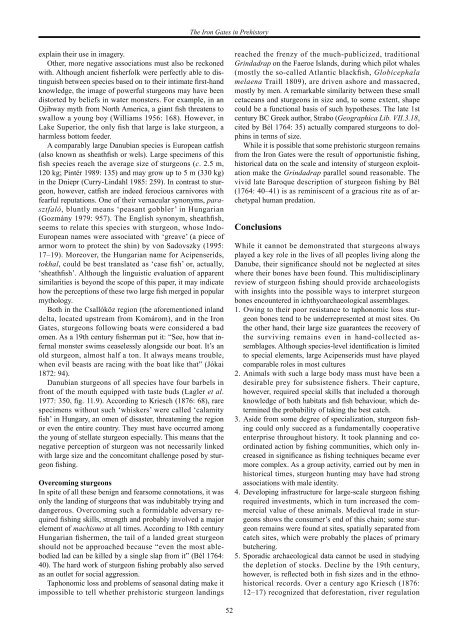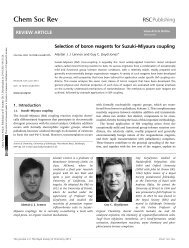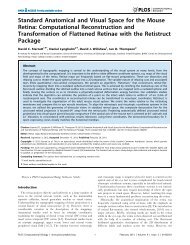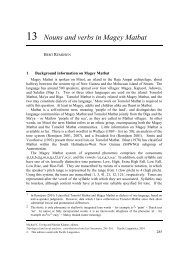Sturgeon fishing in the middle and lower Danube region László ...
Sturgeon fishing in the middle and lower Danube region László ...
Sturgeon fishing in the middle and lower Danube region László ...
You also want an ePaper? Increase the reach of your titles
YUMPU automatically turns print PDFs into web optimized ePapers that Google loves.
expla<strong>in</strong> <strong>the</strong>ir use <strong>in</strong> imagery.<br />
O<strong>the</strong>r, more negative associations must also be reckoned<br />
with. Although ancient fisherfolk were perfectly able to dist<strong>in</strong>guish<br />
between species based on to <strong>the</strong>ir <strong>in</strong>timate first-h<strong>and</strong><br />
knowledge, <strong>the</strong> image of powerful sturgeons may have been<br />
distorted by beliefs <strong>in</strong> water monsters. For example, <strong>in</strong> an<br />
Ojibway myth from North America, a giant fish threatens to<br />
swallow a young boy (Williams 1956: 168). However, <strong>in</strong><br />
Lake Superior, <strong>the</strong> only fish that large is lake sturgeon, a<br />
harmless bottom feeder.<br />
A comparably large Danubian species is European catfish<br />
(also known as sheathfish or wels). Large specimens of this<br />
fish species reach <strong>the</strong> average size of sturgeons (c. 2.5 m,<br />
120 kg; P<strong>in</strong>tér 1989: 135) <strong>and</strong> may grow up to 5 m (330 kg)<br />
<strong>in</strong> <strong>the</strong> Dniepr (Curry-L<strong>in</strong>dahl 1985: 259). In contrast to sturgeon,<br />
however, catfish are <strong>in</strong>deed ferocious carnivores with<br />
fearful reputations. One of <strong>the</strong>ir vernacular synonyms, parasztfaló,<br />
bluntly means ‘peasant gobbler’ <strong>in</strong> Hungarian<br />
(Gozmány 1979: 957). The English synonym, sheathfish,<br />
seems to relate this species with sturgeon, whose Indo-<br />
European names were associated with ‘greave’ (a piece of<br />
armor worn to protect <strong>the</strong> sh<strong>in</strong>) by von Sadovszky (1995:<br />
17–19). Moreover, <strong>the</strong> Hungarian name for Acipenserids,<br />
tokhal, could be best translated as ‘case fish’ or, actually,<br />
‘sheathfish’. Although <strong>the</strong> l<strong>in</strong>guistic evaluation of apparent<br />
similarities is beyond <strong>the</strong> scope of this paper, it may <strong>in</strong>dicate<br />
how <strong>the</strong> perceptions of <strong>the</strong>se two large fish merged <strong>in</strong> popular<br />
mythology.<br />
Both <strong>in</strong> <strong>the</strong> Csallóköz <strong>region</strong> (<strong>the</strong> aforementioned <strong>in</strong>l<strong>and</strong><br />
delta, located upstream from Komárom), <strong>and</strong> <strong>in</strong> <strong>the</strong> Iron<br />
Gates, sturgeons follow<strong>in</strong>g boats were considered a bad<br />
omen. As a 19th century fisherman put it: “See, how that <strong>in</strong>fernal<br />
monster swims ceaselessly alongside our boat. It’s an<br />
old sturgeon, almost half a ton. It always means trouble,<br />
when evil beasts are rac<strong>in</strong>g with <strong>the</strong> boat like that” (Jókai<br />
1872: 94).<br />
Danubian sturgeons of all species have four barbels <strong>in</strong><br />
front of <strong>the</strong> mouth equipped with taste buds (Lagler et al.<br />
1977: 350, fig. 11.9). Accord<strong>in</strong>g to Kriesch (1876: 68), rare<br />
specimens without such ‘whiskers’ were called ‘calamity<br />
fish’ <strong>in</strong> Hungary, an omen of disaster, threaten<strong>in</strong>g <strong>the</strong> <strong>region</strong><br />
or even <strong>the</strong> entire country. They must have occurred among<br />
<strong>the</strong> young of stellate sturgeon especially. This means that <strong>the</strong><br />
negative perception of sturgeon was not necessarily l<strong>in</strong>ked<br />
with large size <strong>and</strong> <strong>the</strong> concomitant challenge posed by sturgeon<br />
<strong>fish<strong>in</strong>g</strong>.<br />
Overcom<strong>in</strong>g sturgeons<br />
In spite of all <strong>the</strong>se benign <strong>and</strong> fearsome connotations, it was<br />
only <strong>the</strong> l<strong>and</strong><strong>in</strong>g of sturgeons that was <strong>in</strong>dubitably try<strong>in</strong>g <strong>and</strong><br />
dangerous. Overcom<strong>in</strong>g such a formidable adversary required<br />
<strong>fish<strong>in</strong>g</strong> skills, strength <strong>and</strong> probably <strong>in</strong>volved a major<br />
element of machismo at all times. Accord<strong>in</strong>g to 18th century<br />
Hungarian fishermen, <strong>the</strong> tail of a l<strong>and</strong>ed great sturgeon<br />
should not be approached because “even <strong>the</strong> most ablebodied<br />
lad can be killed by a s<strong>in</strong>gle slap from it” (Bél 1764:<br />
40). The hard work of sturgeon <strong>fish<strong>in</strong>g</strong> probably also served<br />
as an outlet for social aggression.<br />
Taphonomic loss <strong>and</strong> problems of seasonal dat<strong>in</strong>g make it<br />
impossible to tell whe<strong>the</strong>r prehistoric sturgeon l<strong>and</strong><strong>in</strong>gs<br />
The Iron Gates <strong>in</strong> Prehistory<br />
52<br />
reached <strong>the</strong> frenzy of <strong>the</strong> much-publicized, traditional<br />
Gr<strong>in</strong>dadrap on <strong>the</strong> Faeroe Isl<strong>and</strong>s, dur<strong>in</strong>g which pilot whales<br />
(mostly <strong>the</strong> so-called Atlantic blackfish, Globicephala<br />
melaena Traill 1809), are driven ashore <strong>and</strong> massacred,<br />
mostly by men. A remarkable similarity between <strong>the</strong>se small<br />
cetaceans <strong>and</strong> sturgeons <strong>in</strong> size <strong>and</strong>, to some extent, shape<br />
could be a functional basis of such hypo<strong>the</strong>ses. The late 1st<br />
century BC Greek author, Strabo (Geographica Lib. VII.3.18,<br />
cited by Bél 1764: 35) actually compared sturgeons to dolph<strong>in</strong>s<br />
<strong>in</strong> terms of size.<br />
While it is possible that some prehistoric sturgeon rema<strong>in</strong>s<br />
from <strong>the</strong> Iron Gates were <strong>the</strong> result of opportunistic <strong>fish<strong>in</strong>g</strong>,<br />
historical data on <strong>the</strong> scale <strong>and</strong> <strong>in</strong>tensity of sturgeon exploitation<br />
make <strong>the</strong> Gr<strong>in</strong>dadrap parallel sound reasonable. The<br />
vivid late Baroque description of sturgeon <strong>fish<strong>in</strong>g</strong> by Bél<br />
(1764: 40–41) is as rem<strong>in</strong>iscent of a gracious rite as of archetypal<br />
human predation.<br />
Conclusions<br />
While it cannot be demonstrated that sturgeons always<br />
played a key role <strong>in</strong> <strong>the</strong> lives of all peoples liv<strong>in</strong>g along <strong>the</strong><br />
<strong>Danube</strong>, <strong>the</strong>ir significance should not be neglected at sites<br />
where <strong>the</strong>ir bones have been found. This multidiscipl<strong>in</strong>ary<br />
review of sturgeon <strong>fish<strong>in</strong>g</strong> should provide archaeologists<br />
with <strong>in</strong>sights <strong>in</strong>to <strong>the</strong> possible ways to <strong>in</strong>terpret sturgeon<br />
bones encountered <strong>in</strong> ichthyoarchaeological assemblages.<br />
1. Ow<strong>in</strong>g to <strong>the</strong>ir poor resistance to taphonomic loss sturgeon<br />
bones tend to be underrepresented at most sites. On<br />
<strong>the</strong> o<strong>the</strong>r h<strong>and</strong>, <strong>the</strong>ir large size guarantees <strong>the</strong> recovery of<br />
<strong>the</strong> surviv<strong>in</strong>g rema<strong>in</strong>s even <strong>in</strong> h<strong>and</strong>-collected assemblages.<br />
Although species-level identification is limited<br />
to special elements, large Acipenserids must have played<br />
comparable roles <strong>in</strong> most cultures<br />
2. Animals with such a large body mass must have been a<br />
desirable prey for subsistence fishers. Their capture,<br />
however, required special skills that <strong>in</strong>cluded a thorough<br />
knowledge of both habitats <strong>and</strong> fish behaviour, which determ<strong>in</strong>ed<br />
<strong>the</strong> probability of tak<strong>in</strong>g <strong>the</strong> best catch.<br />
3. Aside from some degree of specialization, sturgeon <strong>fish<strong>in</strong>g</strong><br />
could only succeed as a fundamentally cooperative<br />
enterprise throughout history. It took plann<strong>in</strong>g <strong>and</strong> coord<strong>in</strong>ated<br />
action by <strong>fish<strong>in</strong>g</strong> communities, which only <strong>in</strong>creased<br />
<strong>in</strong> significance as <strong>fish<strong>in</strong>g</strong> techniques became ever<br />
more complex. As a group activity, carried out by men <strong>in</strong><br />
historical times, sturgeon hunt<strong>in</strong>g may have had strong<br />
associations with male identity.<br />
4. Develop<strong>in</strong>g <strong>in</strong>frastructure for large-scale sturgeon <strong>fish<strong>in</strong>g</strong><br />
required <strong>in</strong>vestments, which <strong>in</strong> turn <strong>in</strong>creased <strong>the</strong> commercial<br />
value of <strong>the</strong>se animals. Medieval trade <strong>in</strong> sturgeons<br />
shows <strong>the</strong> consumer’s end of this cha<strong>in</strong>; some sturgeon<br />
rema<strong>in</strong>s were found at sites, spatially separated from<br />
catch sites, which were probably <strong>the</strong> places of primary<br />
butcher<strong>in</strong>g.<br />
5. Sporadic archaeological data cannot be used <strong>in</strong> study<strong>in</strong>g<br />
<strong>the</strong> depletion of stocks. Decl<strong>in</strong>e by <strong>the</strong> 19th century,<br />
however, is reflected both <strong>in</strong> fish sizes <strong>and</strong> <strong>in</strong> <strong>the</strong> ethnohistorical<br />
records. Over a century ago Kriesch (1876:<br />
12–17) recognized that deforestation, river regulation









